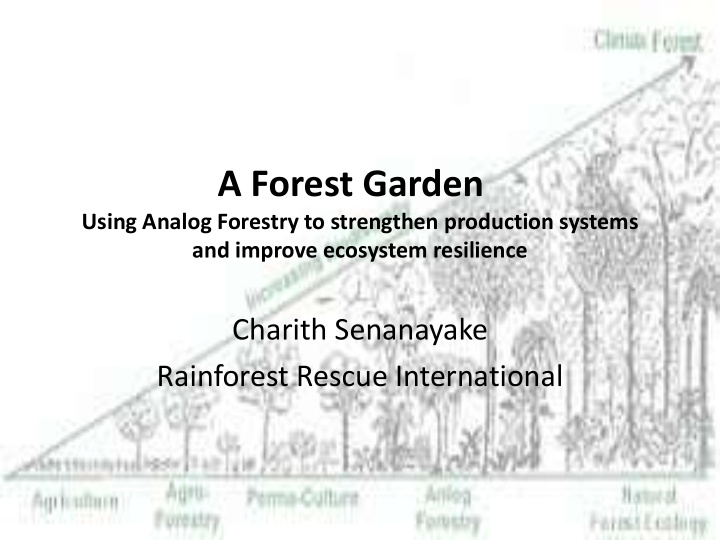



A Forest Garden Using Analog Forestry to strengthen production systems and improve ecosystem resilience Charith Senanayake Rainforest Rescue International
Non timber forest product use Medicinal products Food products
Commodities sourced from forests Sandal wood Coffee
Landscape level change for production purposes
Unsustainable Land Management by communities
Tropical Carbon Sinks
Global Deforestation Rates 2012
Threats to biodiversity Species at danger of extinction 68% 33% 30% 25% 25% 21% Mammals Birds Amphibians Invertebtates Plants Reptiles Conservative estimates propose a loss of around 10,000 Species per Year.
Salinization impacting water quality
Asia Pacific Context Do we have any solutions for the future? Yes ! How? Follow Nature.
Analog forestry • Seeks to establish ecosystems with architectural structures and ecological functions similar to the original climax or sub climax vegetation. • It also seeks to strengthen rural communities, socially as much as economically, through the use of species that provides for food sovereignty and market orientation. • First trials begun 1987, and in April 1994 it was accepted as a methodology integrating the protection of biodiversity within the context of sound landscape management by scientific experts at the Open-ended Intergovernmental Meeting of Scientific Experts on Biological Diversity (sponsored by the UN) in Mexico City.
2.Evaluate 1.Map and resource 4.Design and 3.Identify record availability implement land scape vegetation and restoration level features types production action needs
Ecuador New AF Planting
Ecuador 1 st seral stage
Ecuador 2 nd seral stage
Mature Analog forest in India
Comparative approaches land management.
Farmers following organic approaches and integrate Forest Garden Planning
Value Added Production Coffee Vanilla Banana, Ginger Cardamom
Observations in Timor Leste • In 2013 an Agro-biodiversity survey was completed in three districts by Ambero-GIZ and MAF. • NTFP resource use were also assessed. • An ABD data base was installed at UNTL.
Increasing reliance on pesticide use by farmers. 90% 80% 70% 60% 50% 40% Vegetable farming Rice farming 30% Pesticide use 20% 10% 0% Bagia Baduho Bahamori Umanaico Laculio Bibleo Bahalarawain Loihuno Ossu de cima Ossu rua Muapitine Bauro Tutuala Mehara Com M Com P Baucau Viqueque Lautem
50-75% Reliance of on fuel wood extraction from existing forest for domestic purposes. Source of Fuelwood in Lautem 126 ° 59'30"E 127 ° 8'E 127 ° 16'30"E Legend District SubDistrict Parlamento Suco Lautem Com Village Source of Fuelwood 8 ° 24'S 8 ° 24'S Pairara Tutuala Tutuala Mehara Ra ç a Tutuala Bauro Home garden only Forest only Lautem Home garden and forest Home Production Date: 6/17/2013 Fuiloro Production Agency: GIZ - AMBERO Los Palos 126 ° E Muapitine 8 ° 32'30"S 8 ° 32'30"S 8 ° S 8 ° S Timor Sea Souro Savu Sea Timor-Leste Lore II Timor Sea 0 2 4 8 0 40 80 160 Lore I Kilometers Cacavem Kilometers 10 ° S 10 ° S 126 ° 59'30"E 127 ° 8'E 127 ° 16'30"E 126 ° E
0.2 0.4 0.6 0.8 1.2 Climate impacts faced by communities 0 1 District Suco Baduho Bahamori Baucau Umanaico Bagia Laculio Bibleo Bahalarawain Viqueque Loihuno Ossu de cima Ossu rua Muapitine Bauro Tutuala Lautem Mehara Com M Com P Drought Flood Drought and flood None
ABD Farmer Manuel Ximenes Sara Ida, Baucau
Potential interventions • Policy support by GOTL to promote sustainable and locally appropriate silvicultural programs (AF,FMNR) along all buffer areas, Forest fragments and watersheds and coastline. • Integration of resource mapping (especially watershed) into Village Development Planning. • Promotion of erosion control methodology such as SALT on lands with steep gradients and Improvement of fuel wood supply chain. • Develop existing baselines( such as the ABD database in UNTL) and monitor.
Obrigado – Barak Charith Senanayake Rainforest Rescue International. Level 3, 673 Bourke Street, Melbourne, Victoria 3000, Australia. charith@rainforestrescueinternational.org www.rainforestrescuesrilanka.org
Recommend
More recommend